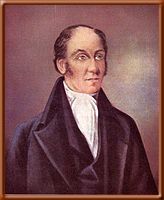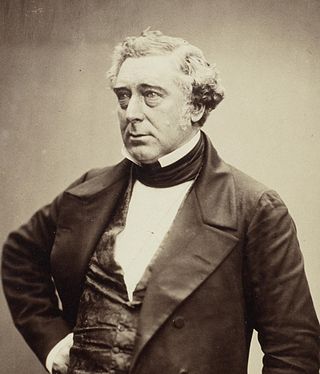
Timothy Hackworth was an English steam locomotive engineer who lived in Shildon, County Durham, England and was the first locomotive superintendent of the Stockton and Darlington Railway.

Robert Stephenson, DCL was an English civil engineer and designer of locomotives. The only son of George Stephenson, the "Father of Railways", he built on the achievements of his father. Robert has been called the greatest engineer of the 19th century. Stephenson's death was widely mourned, and his funeral afforded marks of public honour. He is buried in Westminster Abbey.

The Chicago, Burlington and Quincy Railroad was a railroad that operated in the Midwestern United States. Commonly referred to as the Burlington Route, the Burlington, CB&Q, or as the Q, it operated extensive trackage in the states of Colorado, Illinois, Iowa, Missouri, Nebraska, Wisconsin, Wyoming, and also in Texas through subsidiaries Colorado and Southern Railway, Fort Worth and Denver Railway, and Burlington-Rock Island Railroad. Its primary connections included Chicago, Minneapolis–Saint Paul, St. Louis, Kansas City, and Denver. Because of this extensive trackage in the midwest and mountain states, the railroad used the advertising slogans "Everywhere West", "Way of the Zephyrs", and "The Way West".

The Illinois Central Railroad, sometimes called the Main Line of Mid-America, was a railroad in the Central United States. Its primary routes connected Chicago, Illinois, with New Orleans, Louisiana, and Mobile, Alabama, and thus, the Great Lakes to the Gulf of Mexico. Another line connected Chicago west to Sioux City, Iowa (1870), while smaller branches reached Omaha, Nebraska (1899) from Fort Dodge, Iowa, and Sioux Falls, South Dakota (1877), from Cherokee, Iowa. The IC also ran service to Miami, Florida, on trackage owned by other railroads.

The Grand Trunk Western Railroad Company was an American subsidiary of the Grand Trunk Railway, later of the Canadian National Railway operating in Michigan, Illinois, Indiana, and Ohio. Since a corporate restructuring in 1971, the railroad has been under CN's subsidiary holding company, the Grand Trunk Corporation. Grand Trunk Western's routes are part of CN's Michigan Division. Its primary mainline between Chicago and Port Huron, Michigan serves as a connection between railroad interchanges in Chicago and rail lines in eastern Canada and the Northeastern United States. The railroad's extensive trackage in Detroit and across southern Michigan has made it an essential link for the automotive industry as a hauler of parts and automobiles from manufacturing plants.

The EMD SW1 is a 600-horsepower (450 kW) diesel-electric switcher locomotive built by General Motors' Electro-Motive Corporation between December 1938 and November 1953. Final assembly was at EMD's plant at LaGrange (McCook) Illinois. The SW1 was the second generation of 3,402 cu in (55.75 L) switcher from EMD, succeeding the SC and SW. The most significant change from those earlier models was the use of an engine of EMD's own design, the then-new 567 engine, here in 600 hp (450 kW) V6 form. 661 locomotives of this design were built, with a gap in production between March 1943 and September 1945 due to World War II.

The Michigan Central Railroad was originally chartered in 1832 to establish rail service between Detroit, Michigan, and St. Joseph, Michigan. The railroad later operated in the states of Michigan, Indiana, and Illinois in the United States and the province of Ontario in Canada. After about 1867 the railroad was controlled by the New York Central Railroad, which later became part of Penn Central and then Conrail. After the 1998 Conrail breakup, Norfolk Southern Railway now owns much of the former Michigan Central trackage.

Chester railway station is located in Newtown, Chester, England. Services are operated by Avanti West Coast, Merseyrail, Northern and Transport for Wales. From 1875 to 1969, the station was known as Chester General to distinguish it from Chester Northgate. The station's Italianate frontage was designed by the architect Francis Thompson.
The Chester and Holyhead Railway was an early railway company conceived to improve transmission of Government dispatches between London and Ireland, as well as ordinary railway objectives. Its construction was hugely expensive, chiefly due to the cost of building the Britannia Tubular Bridge over the Menai Strait. The company had relied on Government support in facilitating the ferry service, and this proved to be uncertain. The company opened its main line throughout in 1850. It relied on the co-operation of other railways to reach London, and in 1859 it was absorbed by the London and North Western Railway.

Railroads have been vital in the history of the population and trade of rough and finished goods in the state of Michigan. While some coastal settlements had previously existed, the population, commercial, and industrial growth of the state further bloomed with the establishment of the railroad.

The Minneapolis, St. Paul and Sault Ste. Marie Railroad (MStP&SSM) was a Class I railroad subsidiary of the Canadian Pacific Railway in the Midwestern United States. Commonly known since its opening in 1884 as the Soo Line after the phonetic spelling of Sault, it was merged with several other major CP subsidiaries on January 1, 1961, to form the Soo Line Railroad.
The following is a brief history of the North American rail system, mainly through major changes to Class I railroads, the largest class by operating revenue.

The Wabash Railroad was a Class I railroad that operated in the mid-central United States. It served a large area, including track in the states of Ohio, Indiana, Illinois, Iowa, Michigan, and Missouri and the province of Ontario. Its primary connections included Chicago, Illinois; Kansas City, Missouri; Detroit, Michigan; Buffalo, New York; St. Louis, Missouri; and Toledo, Ohio.











